CyberTAN Technology WM610M 802.11b/g miniPCI Module User Manual WM610 M User s Manual draft
CyberTAN Technology Inc. 802.11b/g miniPCI Module WM610 M User s Manual draft
Users Manual
WM610-M
54M Wireless LAM Module
OEM Guide
User’s Manual
Rev 1.0

54M Wireless LAN Module User’s Manual
2
Federal Communication Commission Interference Statement
This equipment has been tested and found to comply with the limits for a Class B
digital device, pursuant to Part 15 of the FCC Rules. These limits are designed to
provide reasonable protection against harmful interference in a residential installation.
This equipment generates, uses and can radiate radio frequency energy and, if not
installed and used in accordance with the instructions, may cause harmful interference
to radio communications. However, there is no guarantee that interference will not
occur in a particular installation. If this equipment does cause harmful interference to
radio or television reception, which can be determined by turning the equipment off and
on, the user is encouraged to try to correct the interference by one of the following
measures:
- Reorient or relocate the receiving antenna.
- Increase the separation between the equipment and receiver.
- Connect the equipment into an outlet on a circuit different from that
to which the receiver is connected.
- Consult the dealer or an experienced radio/TV technician for help.
FCC Caution: Any changes or modifications not expressly approved by the party
responsible for compliance could void the user's authority to operate this equipment.
This device complies with Part 15 of the FCC Rules. Operation is subject to the
following two conditions: (1) This device may not cause harmful interference, and (2)
this device must accept any interference received, including interference that may cause
undesired operation.
IMPORTANT NOTE:
FCC Radiation Exposure Statement:
This equipment should be installed and operated with a minimum distance of 20 centimeters
between the radiator and your body.
This transmitter must not be co-located or operating in conjunction with any other
antenna or transmitter.

54M Wireless LAN Module User’s Manual
3
About this manual
This User’s Manual describes how to install and operate your 54M Wireless LAN
Module. Please read this manual before you install the product.
This manual includes the following topics:
Product description and features.
Software installation procedure.

54M Wireless LAN Module User’s Manual
4
Table of Contents
About this manual ............................................................ 3
Chapter 1 - Introduction................................................... 5
Features .............................................................................................. 5
What is Wireless LAN?........................................................................ 6
Wireless LAN Modes........................................................................... 6
Notes on Wireless LAN Configuration................................................. 7
Chapter 2 – Driver Installation for Windows .................... 8
Driver installation for Windows 98 ....................................................... 8
Driver installation for Windows 2000 ................................................. 11
Driver installation for Windows ME.................................................... 14
Driver installation for Windows XP .................................................... 16

54M Wireless LAN Module User’s Manual
5
Chapter 1 - Introduction
Thank you for purchasing the 54M Wireless LAN Module. This high-speed Wireless
LAN Module provides you with an innovative wireless networking solution. The
Adapter is easy to set up and use. With this innovative wireless technology, you can
share files and printers on the network—without inconvenient wires!
The Module is a network Module with a rate of 1, 2, 5.5, 6, 9, 11, 12, 24, 36, 48
and 54 Mbps operating in the ISM band using Direct Sequence Spread Spectrum
(DSSS) transmission implementing the IEEE 802.11g draft standard. This Module
provides Device Drivers for Windows Operating Systems. It also provides tools
for the configuration of the Module. The tool, as well as the installation steps of
the plug-and-play procedure for the Windows operating systems, is described in
this document.
Features
The 54M Wireless LAN Module offers compliance with the IEEE 802.11g draft
specification. This feature allows them to communicate with other wireless
devices that support the standard. Features of the Module are:
Uses 2.4GHz frequency band, which complies with worldwide
requirement
Wireless interface following the IEEE 802.11g and 802.11b standard
Using MiniPCI interface
Enciphering/deciphering of wireless data by the implementation of the
WEP/WPA/WPA2 algorithm
Wire-free access to networked resources from anywhere beyond the
notebook
Allows users move between Access Points without resetting their
connection reconfiguration
Delivers data rate up to 54 Mbps
Supports 1, 2, 5.5, 6, 9, 11, 12, 24, 36, 48 and 54 Mbps rates
Provide Wireless LAN Card Configuration utility
The module uses external Antenna
Supports most popular operating systems

54M Wireless LAN Module User’s Manual
6
What is Wireless LAN?
Wireless Local Area Network (WLAN) systems offer a great number of
advantages over traditional wired systems. WLAN is flexible and easy to setup
and manage. They are also more economical than wired LAN systems.
Using radio frequency (RF) technology, WLAN transmit and receive data through
the air. WLAN combine data connectivity with user mobility. For example, users
can roam from a conference room to their office without being disconnected from
the LAN.
Using WLAN, users can conveniently access-shared information, and network
administrators can configure and augment networks without installing or moving
network cables.
WLAN technology provides users with many convenient and cost saving features:
• Mobility: WLAN provide LAN users with access to real-time information
anywhere in their organization, providing service opportunities that are
impossible with wired networks.
• Ease of Installation: Installing is easy for novice and expert users alike,
eliminating the need to install network cables in walls and ceilings.
• Scalability: WLAN can be configured in a variety of topologies to adapt to
specific applications and installations. Configurations are easily changed
and range from peer-to-peer networks suitable for a small number of users
to full infrastructure networks of thousands of users roaming over a broad
area.
Wireless LAN Modes
Wireless LANs can be configured in one of two ways:
Ad-hoc
Networking
Also known as a peer-to-peer network, an ad-hoc
network is one that allows all workstations and
computers in the network to act as servers to all other
users on the network. Users on the network can share
files, print to a shared printer, and access the Internet
with a shared modem. However, with ad-hoc
networking, users can only communicate with other
wireless LAN computers that are in the wireless LAN
workgroup, and are within range.
Infrastructure
Networking
Infrastructure networking differs from ad-hoc
networking in that it includes an access point. Unlike
the ad-hoc structure where users on the LAN contend
the shared bandwidth, on an infrastructure network the
access point can manage the bandwidth to maximize
bandwidth utilization.

54M Wireless LAN Module User’s Manual
7
Additionally, the access point enables users on a
wireless LAN to access an existing wired network,
allowing wireless users to take advantage of the wired
networks resources, such as Internet, email, file
transfer, and printer sharing.
Infrastructure networking has the following advantages
over ad-hoc networking:
• Extended range: each wireless LAN computer
within the range of the access point can
communicate with other wireless LAN computers
within range of the access point.
• Roaming: the access point enables a wireless
LAN computer to move through a building and still
be connected to the LAN.
• Wired to wireless LAN connectivity: the access
point bridges the gap between wireless LANs and
their wired counterparts.
Notes on Wireless LAN Configuration
When configuring a wireless LAN (WLAN), be sure to note the following points:
• Optimize the performance of the WLAN by ensuring that the distance
between access points is not too far. In most buildings, WLAN Adapters
operate within a range of 100 ~ 300 feet, depending on the thickness and
structure of the walls.
• Radio waves can pass through walls and glass but not metal. If there is
interference in transmitting through a wall, it may be that the wall has
reinforcing metal in its structure. Install another access point to circumvent
this problem.
• Floors usually have metal girders and metal reinforcing struts that interfere
with WLAN transmission.
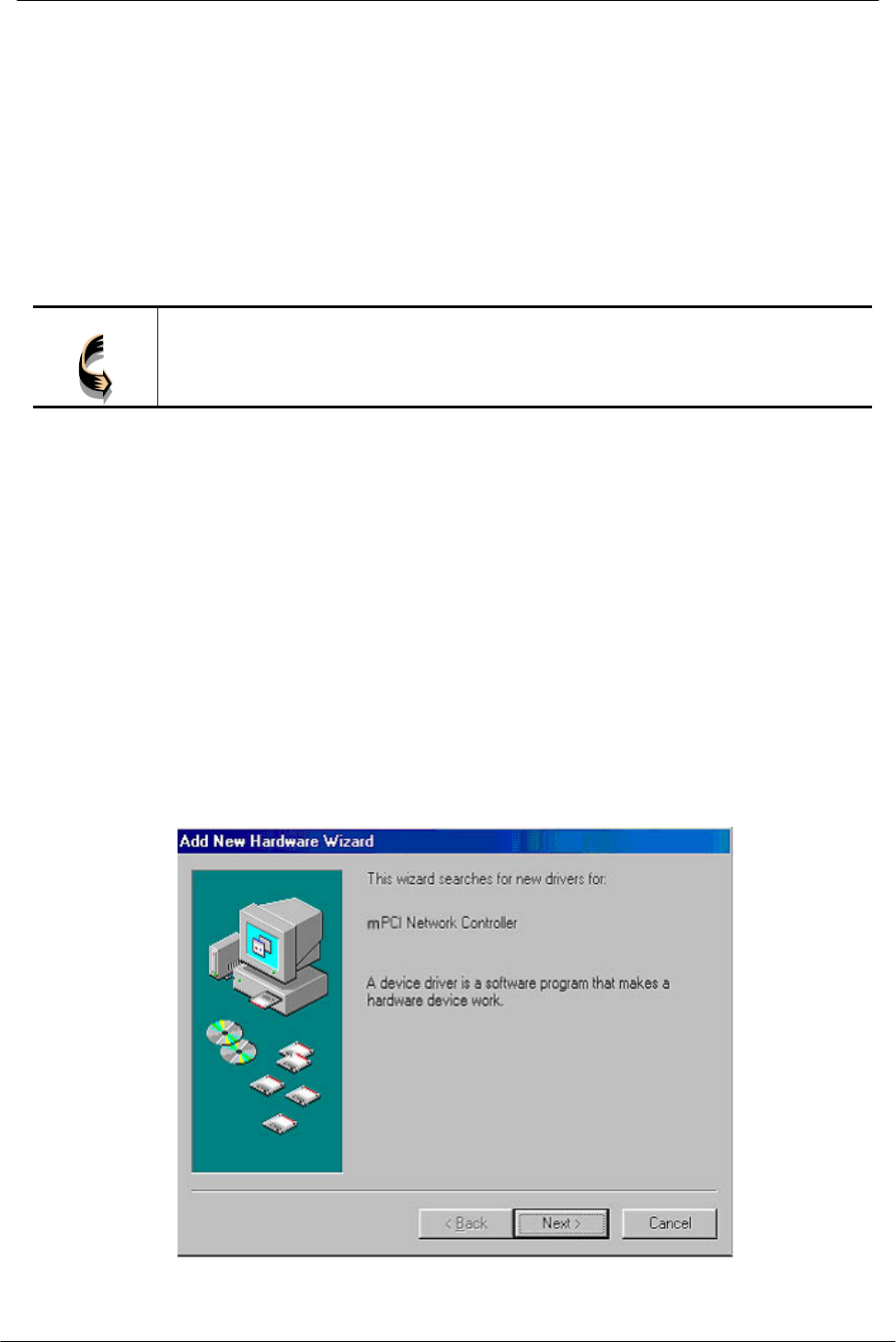
54M Wireless LAN Module User’s Manual
8
Chapter 2 – Driver Installation for Windows
The following sections cover Wireless LAN Module driver installation in the Windows
Operating Systems.
Note!
You have to install your hardware first before you begin to install
the drivers.
Driver installation for Windows 98
Follow the steps below to install the Wireless LAN Module drivers for Windows 98.
1. Insert driver CD-ROM and turn off your notebook.
2. Release the screws and open the miniPCI slot cover (It should located on the back
of your notebook) carefully.
3. Insert the miniPCI Wireless LAN Card to miniPCI slot of notebook securely. (Refer
to Chapter 2 – Hardware installation.)
4. Turn on your notebook.
5. After Windows 98 detects the Wireless LAN Module, the Add New Hardware
Wizard window appears. Clicks Next to continue the installation.
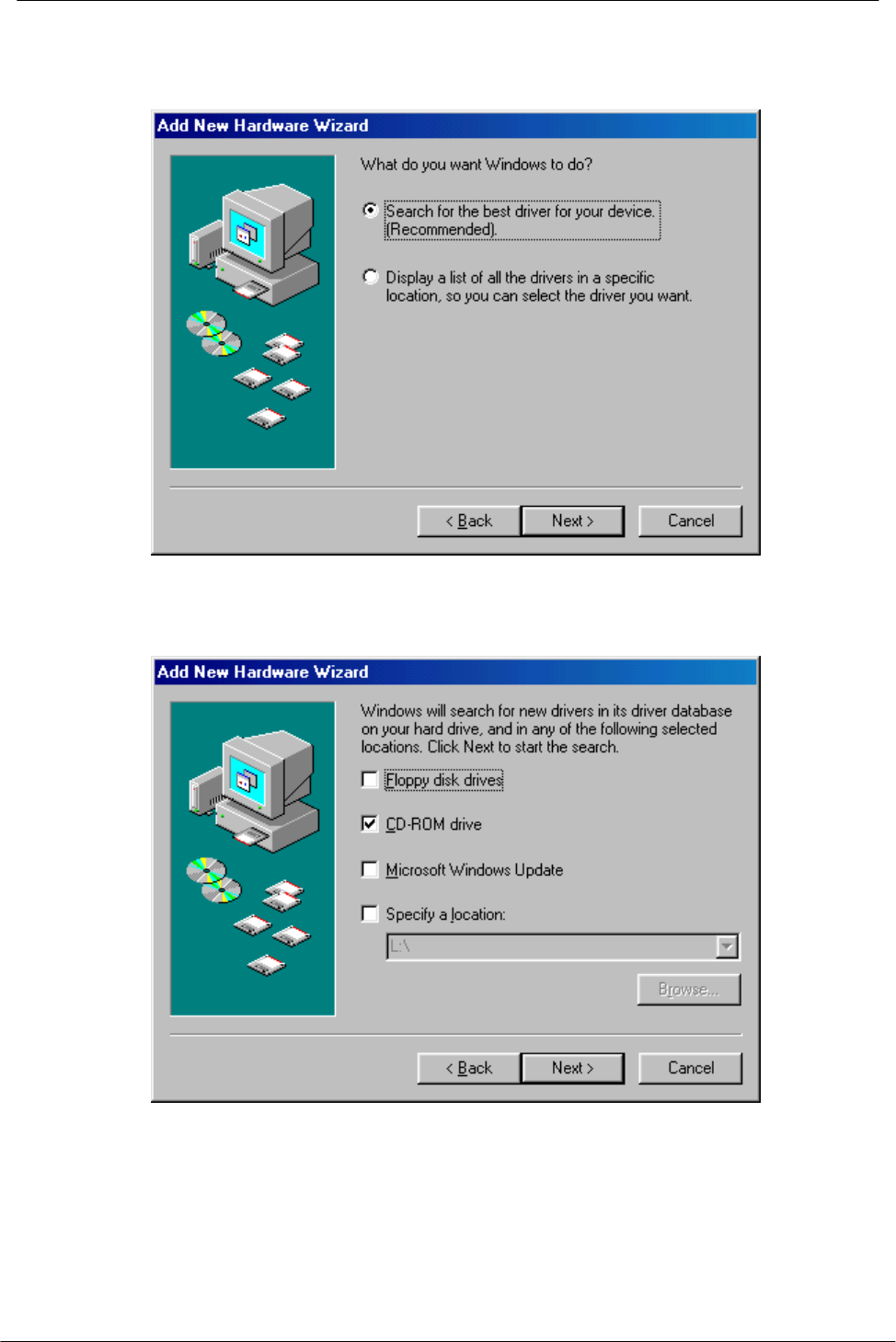
54M Wireless LAN Module User’s Manual
9
6. A screen appears prompting you to select an installation method. Select Search for
the best driver for your device. (Recommended) and click Next to continue.
7. Ensure that the CD-ROM drive is selected. Inserts the driver CD-ROM into your
CD-ROM drive and clicks Next to continue.
8. The following screen appears showing the driver search result. Click Next to
continue the installation.
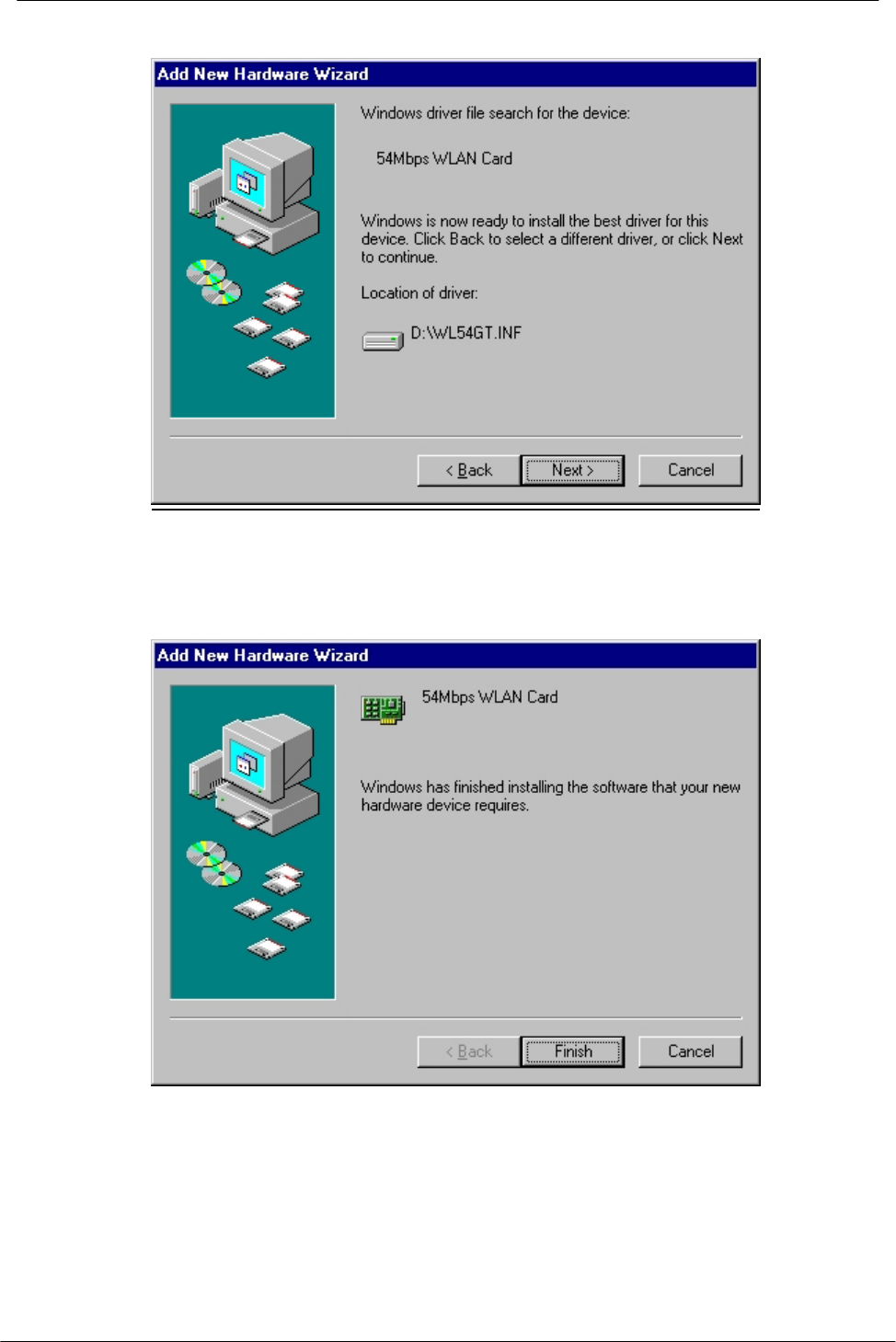
54M Wireless LAN Module User’s Manual
10
9. Windows 98 copies files to your hard disk. The following screen will appear to
inform you when the software installation has finished. Click Finish to finish the
installation.
10. The following screen will ask you to restart your computer to finish the installation.
Click Yes to reboot the system. After system reboot, the Wireless LAN Utility will be
installed automatically. Please go to Chapter 4 to install the utility.
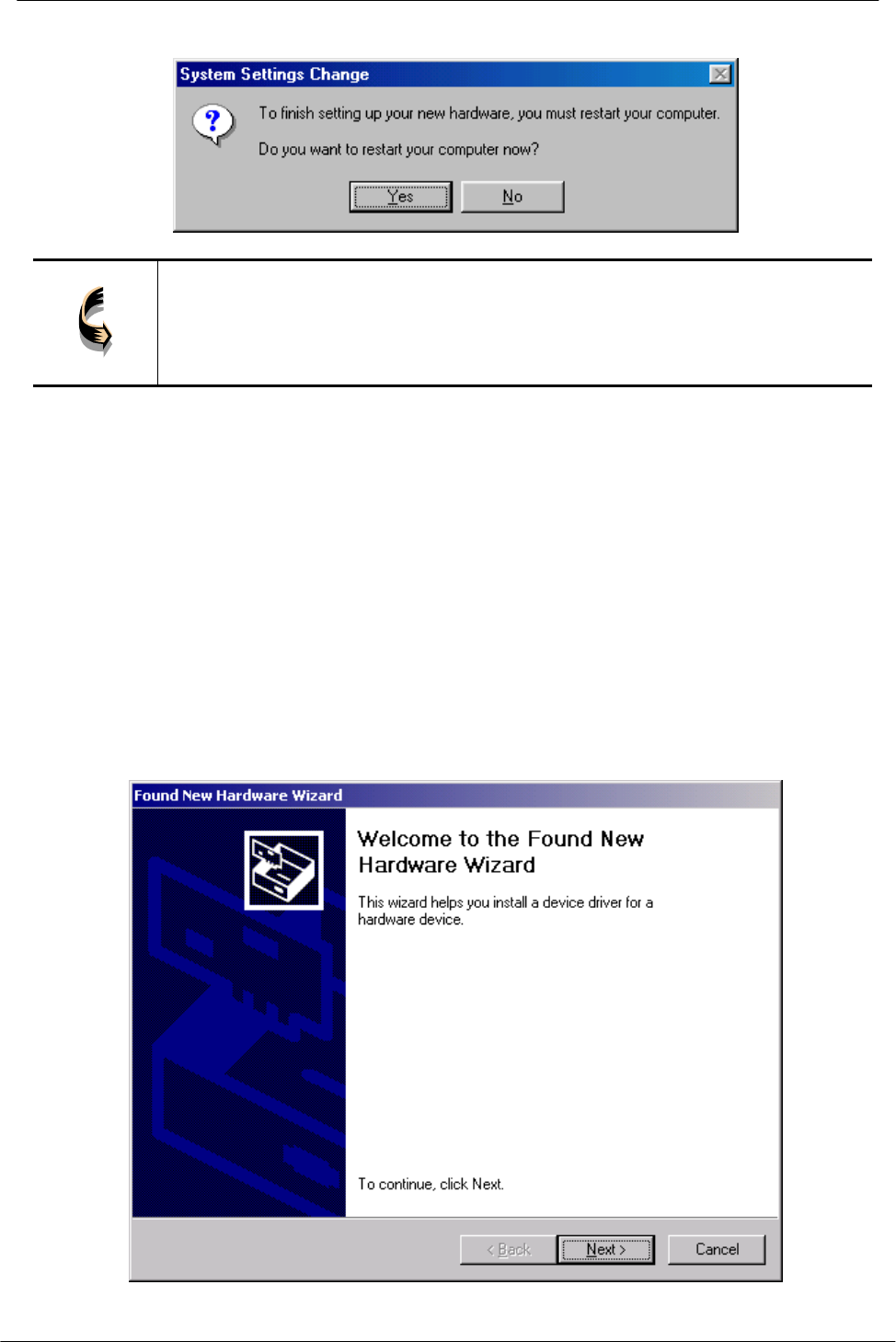
54M Wireless LAN Module User’s Manual
11
Note!
In most cases, Windows will automatically copy all of the files needed
for networking. If Windows asks you for the files and prompts you to
input the path to the files. Follow the instructions on your screen, and
then click OK to continue.
Driver installation for Windows 2000
Follow the steps below to install the MiniPCI Wireless LAN Card drivers for Windows
2000.
1. Insert Driver CD-ROM and Turn off your notebook.
2. Release the screws and open the miniPCI slot cover (It should located on the back
of your notebook) carefully.
3. Insert the MiniPCI Wireless LAN Card to MiniPCI slot of notebook securely. (Refer
to Chapter 2 – Hardware installation.)
4. Turn on your notebook
5. After Windows 2000 detects the MiniPCI Wireless LAN Card, the Found New
Hardware Wizard window appears. Click Next to start the installation.
6. A screen appears prompting you to select an installation method. Select Search
for a suitable driver for my device (recommended) and click Next to continue.
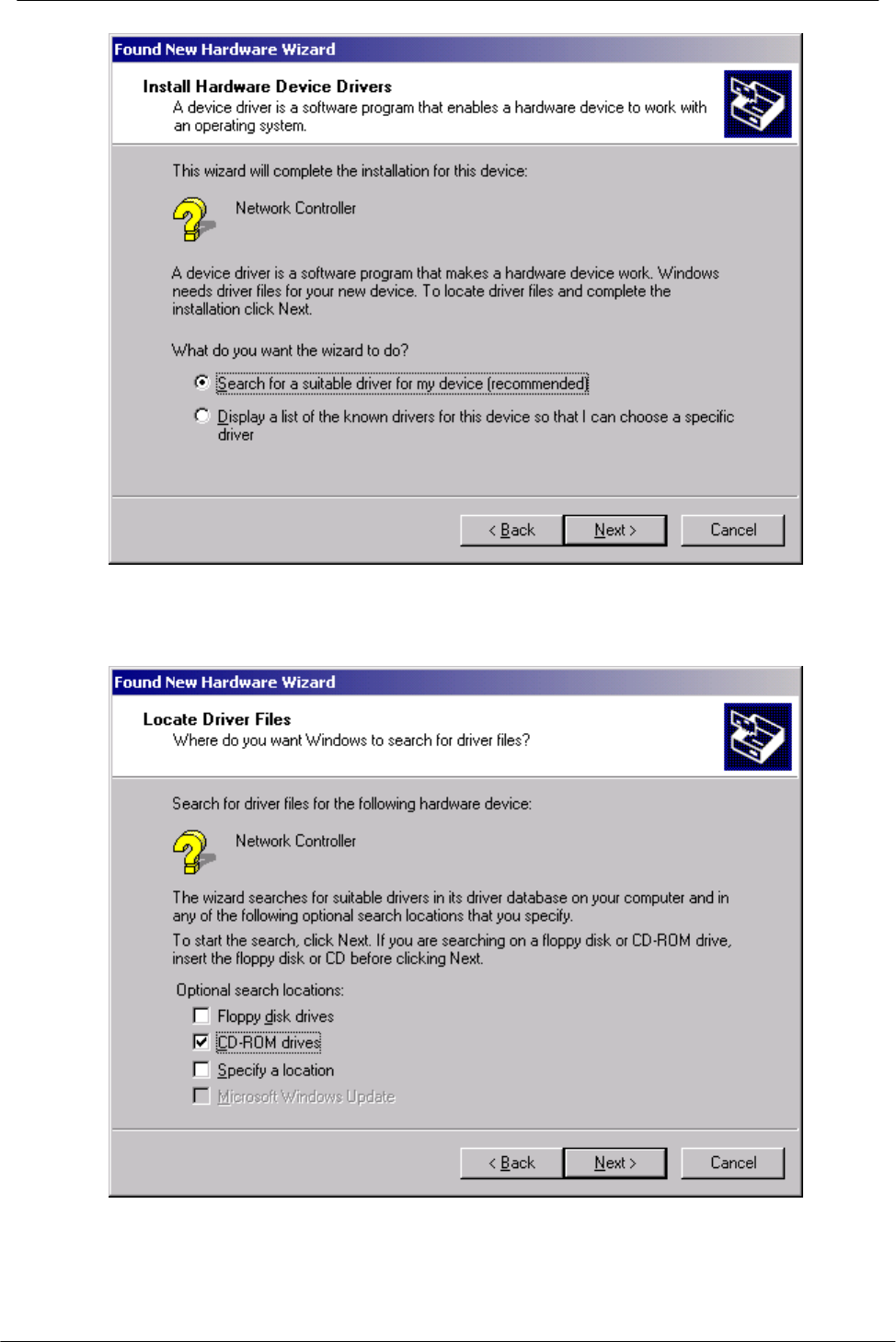
54M Wireless LAN Module User’s Manual
12
7. Ensure that the CD-ROM driver is selected and insert the driver CD-ROM into
your CD-ROM drive and click Next to continue.
8. The following screen appears showing the driver search result. Click Next to
continue the installation.
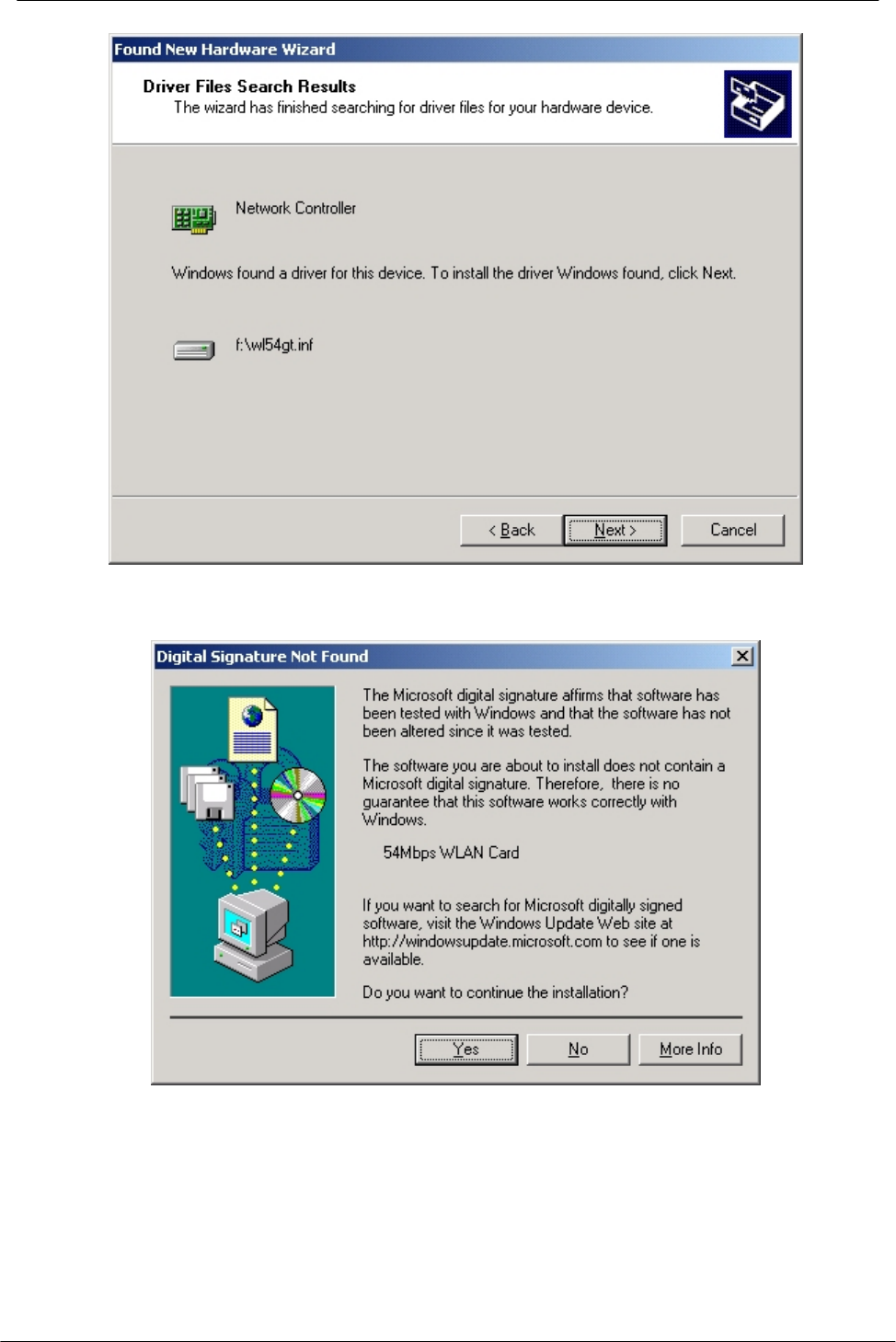
54M Wireless LAN Module User’s Manual
13
9. The following screen appears. Click Yes to continue
10. The Windows has finished installing software for the device. Click Finish to finish
the installation.
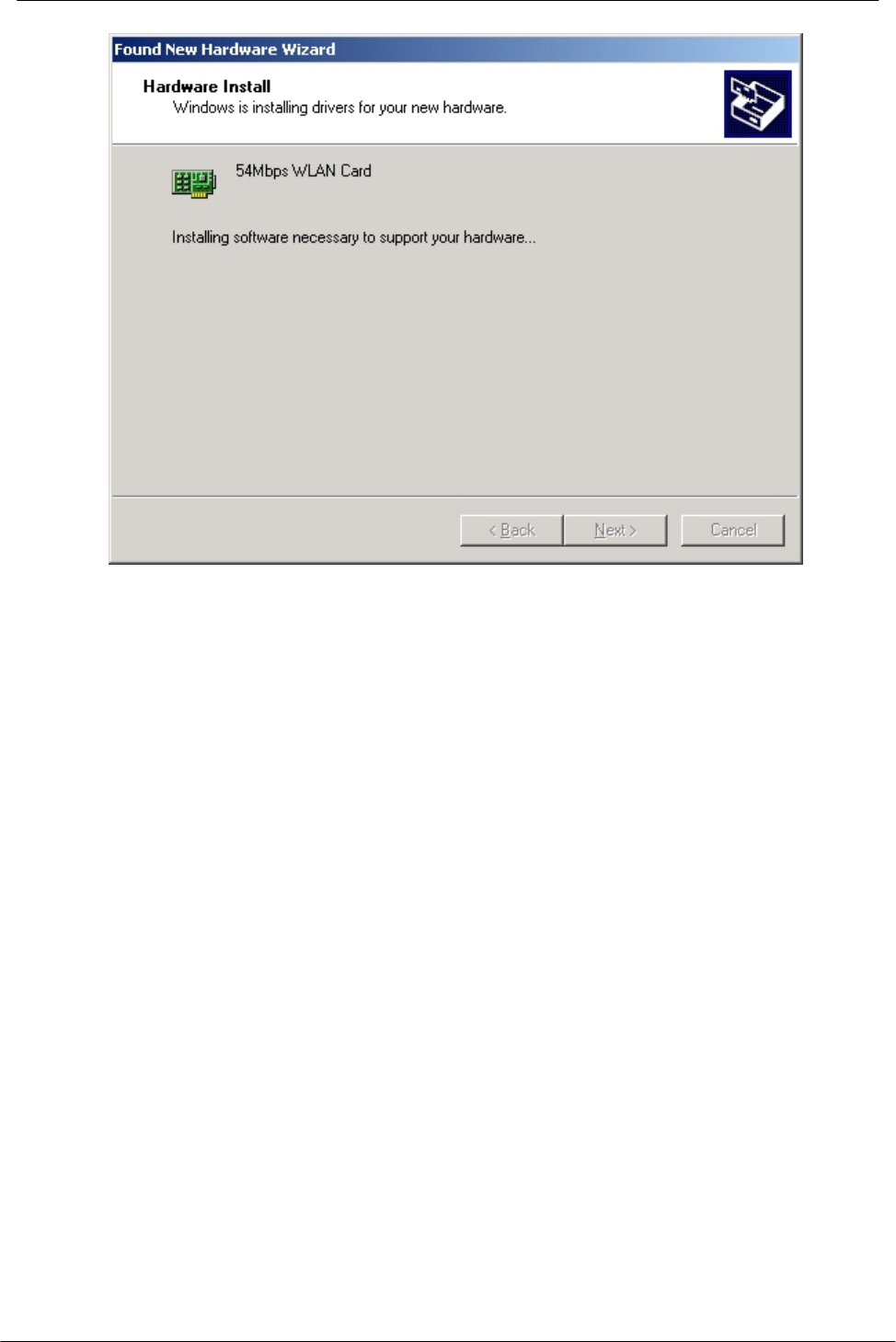
54M Wireless LAN Module User’s Manual
14
Then system will start to install Wireless LAN Utility. Please refer to procedures at
Chapter 4.
Driver installation for Windows ME
Follow the steps below to install the MiniPCI Wireless LAN Card drivers for Windows
ME.
1. Insert Driver CD-ROM and Turn off your notebook.
2. Release the screws and open the miniPCI slot cover (It should located on the back
of your notebook) carefully.
3. Insert the MiniPCI Wireless LAN Card to MiniPCI slot of notebook securely. (Refer
to Chapter 2 – Hardware installation.)
4. Turn on your notebook
5. After Windows ME detects the miniPCI Wireless LAN Card, the Add New
Hardware Wizard window appears. Select Automatic search for a better driver
(Recommended) and insert the driver CD-ROM into CD-ROM drive and click Next
to continue.
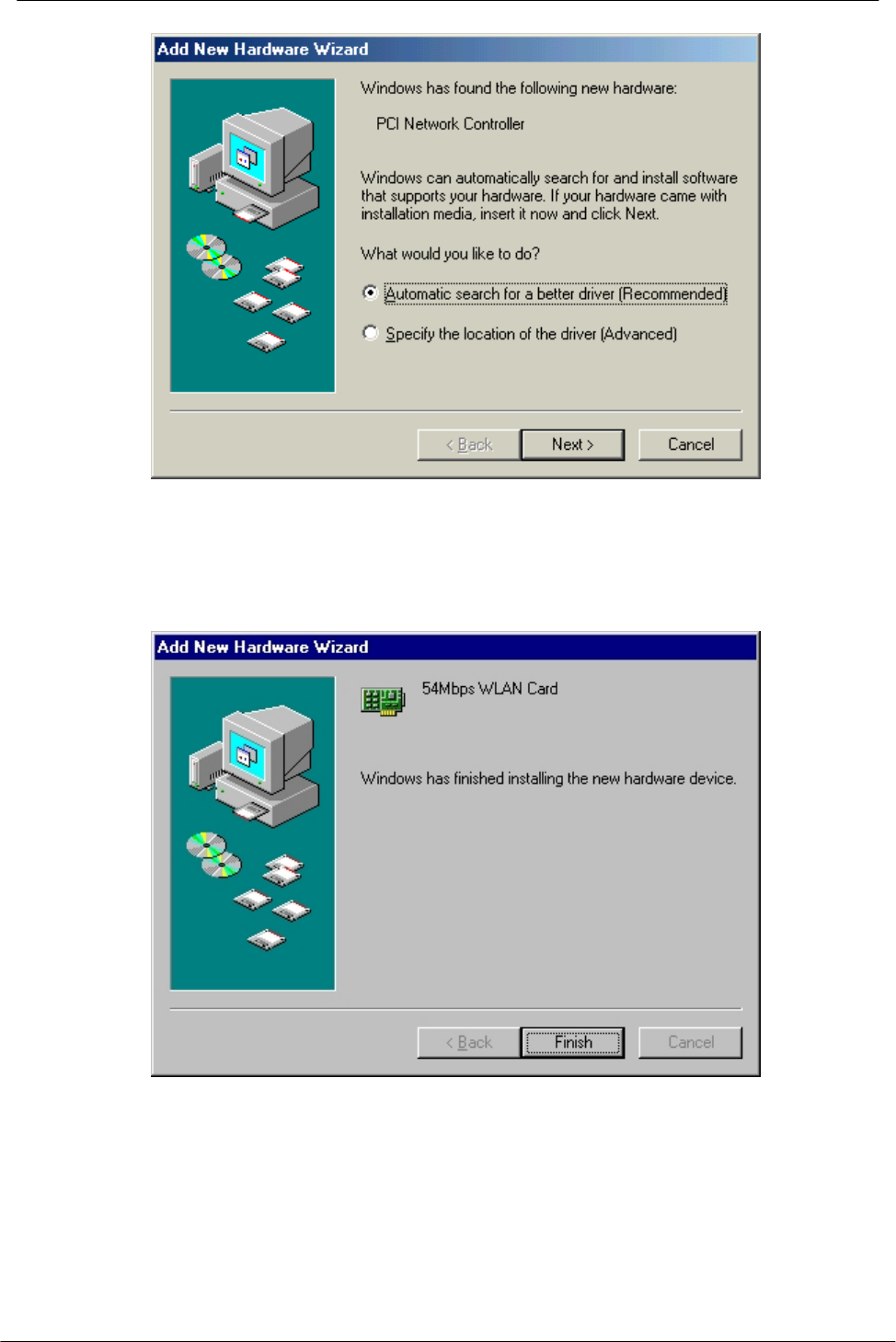
54M Wireless LAN Module User’s Manual
15
6. The system will find the setup files and follow the instruction to copy files to your
hard disk. The following screen will appear when the software installation has
finished. Click Finish to finish the installation.
7. The following screen will ask you to restart your computer to finish the hardware
setting up. Click Yes to reboot the system. After system reboot, the Wireless LAN
Utility will be installed automatically. Please go to Chapter 4 to install the utility.
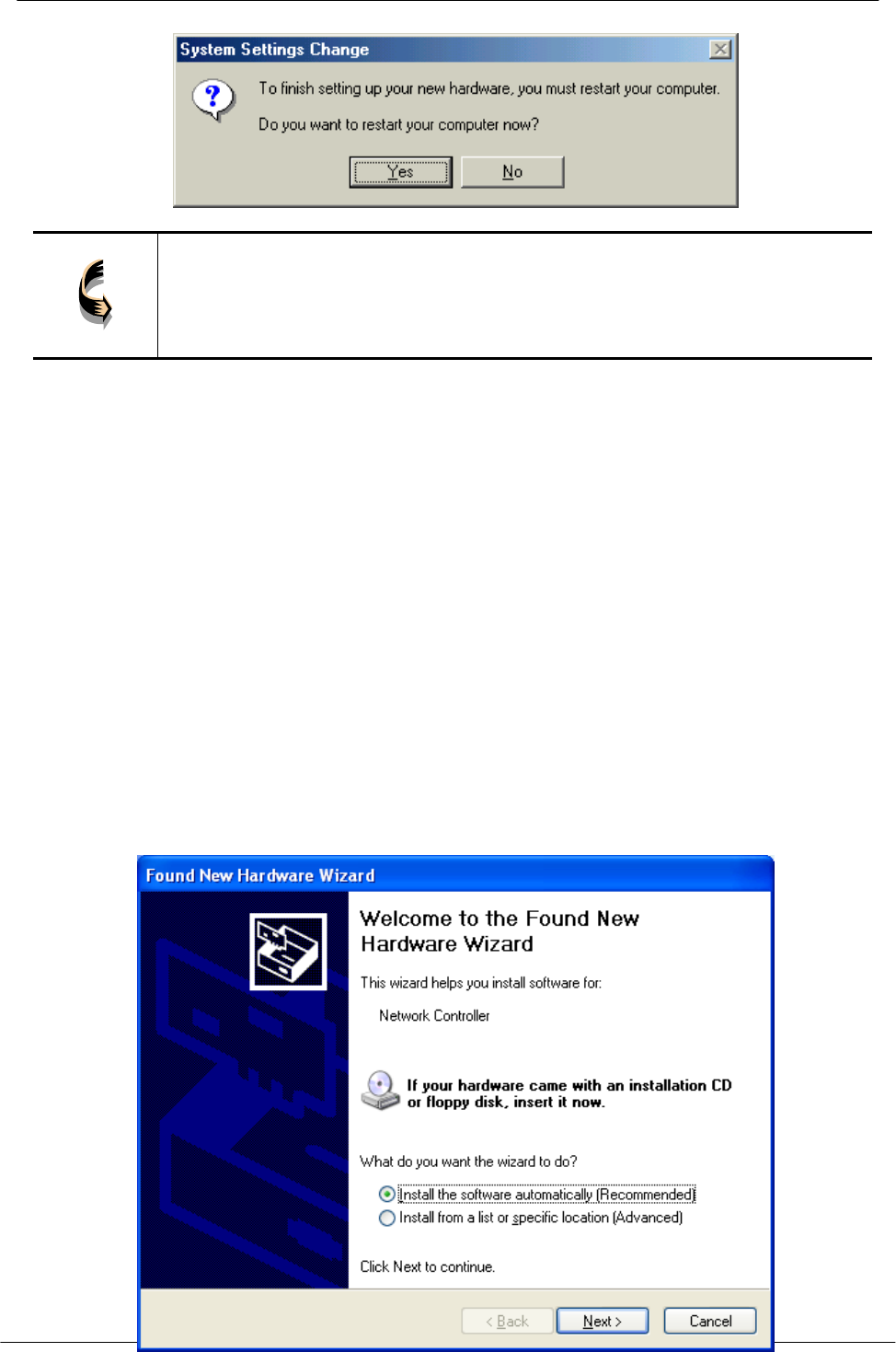
54M Wireless LAN Module User’s Manual
16
Note!
In most cases, Windows will automatically copy all of the files needed
for networking. If Windows asks you for the files and prompts you to
input the path to the files. Follow the instructions on your screen, and
then click OK to continue.
Driver installation for Windows XP
Follow the steps below to install the MiniPCI Wireless LAN Card drivers for Windows
XP.
1. Insert the driver CD to your CD-ROM and turn off notebook.
2. Release the screws and open the miniPCI slot cover (It should located on the
back of your notebook) carefully.
3. Insert the MiniPCI Wireless LAN Card to miniPCI slot of notebook securely.
(Refer to Chapter 2 – Hardware installation.)
4. Turn on your notebook.
5. After Windows XP detects the miniPCI Wireless LAN Card, the Found New
Hardware Wizard window appears. Select Install the software automatically
[Recommended] and insert the driver CD-ROM into CD-ROM drive and click
Next to continue.
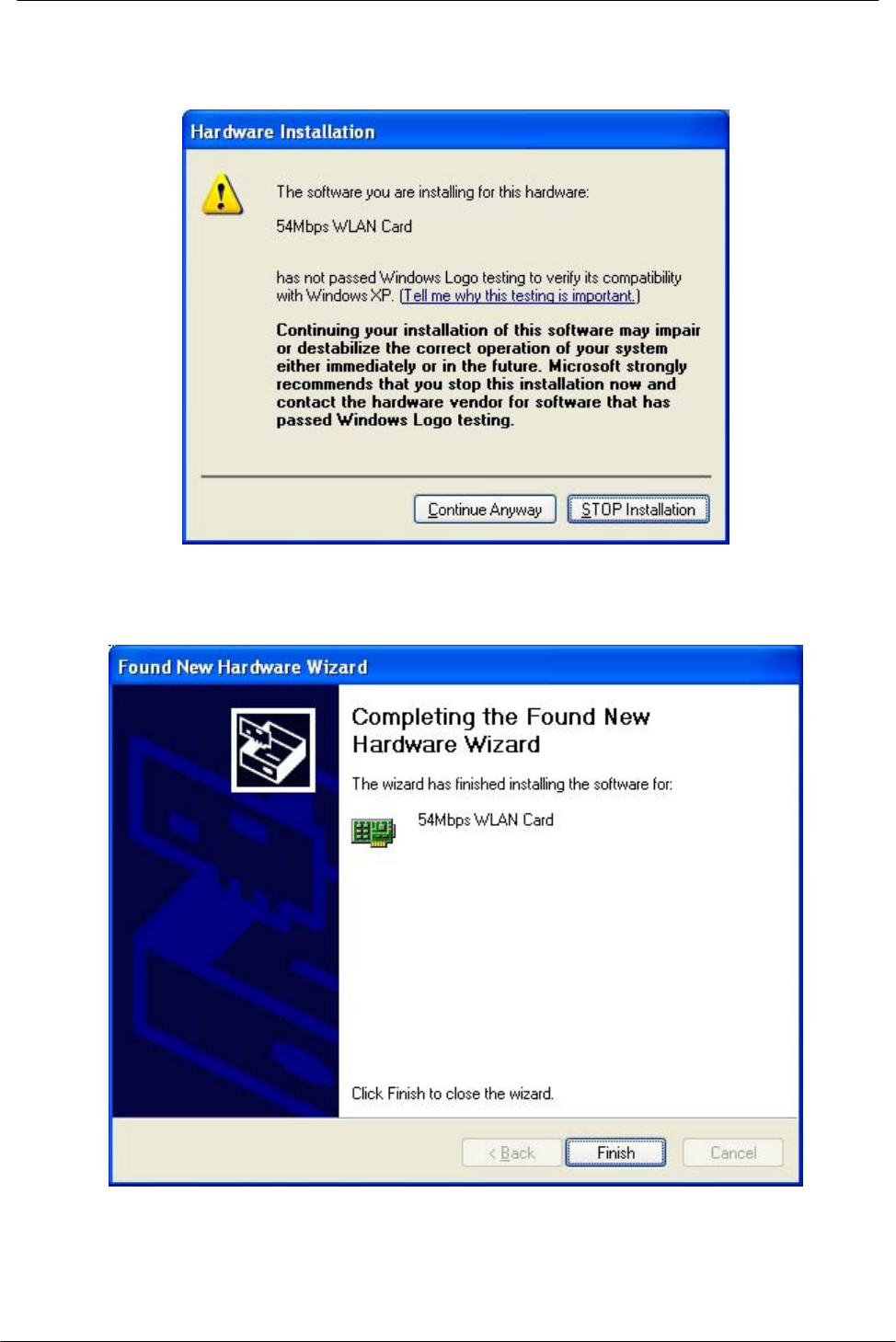
54M Wireless LAN Module User’s Manual
17
6. Click Continue Anyway to continue the installation.
7. The Windows has finished installing software for the device. Click Finish to finish
the installation
Then system will start to install Wireless utility automatically.
End Product Labeling
The final end product must be labeled in a visible area with the following:
" Contains Transmitter Module FCC ID: N89-WM610M"or "Contains
TX FCC ID: N89-WM610M".